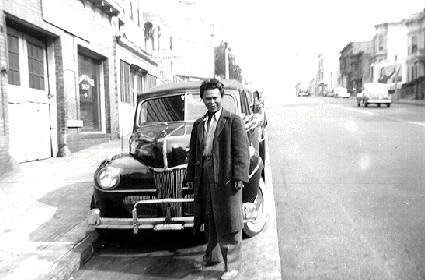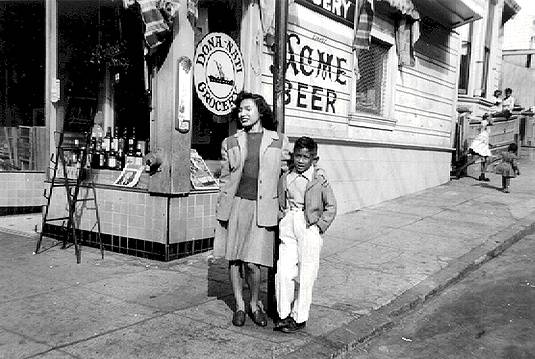Fillmore filipinos: Difference between revisions
No edit summary |
m (Protected "Fillmore filipinos": finished essay [edit=sysop:move=sysop]) |
||
| (3 intermediate revisions by 2 users not shown) | |||
| Line 1: | Line 1: | ||
'''<font face = Papyrus> <font color = maroon> <font size = 4>Historical Essay</font></font> </font>''' | |||
''by James Sobredo & Fred Basconcillo'' | |||
[[Image:filipin1$filipino-man.jpg]] | [[Image:filipin1$filipino-man.jpg]] | ||
Filipino man poses with a car in this image (1940s | '''Filipino man poses with a car in this image (c. 1940s)''' <BR>''Photo: Pacifico Mortel'' | ||
The Fillmore District has long been known as a Japanese American community and later an African American community. For a several years, however, the Fillmore was once also home to the largest Filipino community in San Francisco. At its height in the 1940s, over 1,000 Filipinos and their families live in the Fillmore/ Western Addition. | The Fillmore District has long been known as a Japanese American community and later an African American community. For a several years, however, the Fillmore was once also home to the largest Filipino community in San Francisco. At its height in the 1940s, over 1,000 Filipinos and their families live in the Fillmore/Western Addition. | ||
When people think of the Filipino community in San Francisco, they generally remember the community along Kearny Street with its numerous Filipino restaurants, lunch counters, barbershops, and fraternal organization clubhouses. This community, which was called "Manilatown" by its residents, existed from the 1920s to the 1950s and was home to a few hundred Filipinos. They were mostly single males who worked as migrant laborers in the California farms and Alaska salmon canneries. "Manilatown" was mostly a bachelor society, however, and married Filipinos along with their families lived in another and lesser known community: the Fillmore or Western Addition District. | When people think of the Filipino community in San Francisco, they generally remember the community along Kearny Street with its numerous Filipino restaurants, lunch counters, barbershops, and fraternal organization clubhouses. This community, which was called [[MANILATOWN|"Manilatown"]] by its residents, existed from the 1920s to the 1950s and was home to a few hundred Filipinos. They were mostly single males who worked as migrant laborers in the California farms and Alaska salmon canneries. "Manilatown" was mostly a bachelor society, however, and married Filipinos along with their families lived in another and lesser known community: the Fillmore or Western Addition District. | ||
Japanese Americans were the previous residents of the Fillmore, but at the outbreak of World War II, racially discriminatory government policies forced the evacuation and internment of Japanese residents. Their homes, which they were forced to sell at lower prices, were purchased by Filipinos and African Americans who became the next residents of the Fillmore. Filipinos and African American were attracted to the Bay Area by shipbuilding jobs in the Hunters Point Naval Shipyards and lower housing prices in the Fillmore. | [[Japanese in Western Addition |Japanese Americans]] were the previous residents of the Fillmore, but at the outbreak of World War II, racially discriminatory government policies forced the evacuation and internment of Japanese residents. Their homes, which they were forced to sell at lower prices, were purchased by Filipinos and African Americans who became the next residents of the Fillmore. Filipinos and African American were attracted to the Bay Area by shipbuilding jobs in the Hunters Point Naval Shipyards and lower housing prices in the Fillmore. | ||
At its height, there were over 230 Filipino families in the Fillmore. Most of the families worked in the Naval Shipyards, which in World War II meant both parents were working. During the War years, women were able to find jobs in the Naval Shipyards as welders and fitters. | At its height, there were over 230 Filipino families in the Fillmore. Most of the families worked in the Naval Shipyards, which in World War II meant both parents were working. During the War years, women were able to find jobs in the Naval Shipyards as welders and fitters. | ||
In 1948 when San Francisco passed laws eliminating racially discriminatory housing practices, Filipinos were able to move out of the Fillmore into the Bayview District and eventually to Daly City. Today Daly City, with a large Filipino community and a Filipino-American mayor, is known as the "Manilatown" in the San Francisco Bay area. | In 1948 when San Francisco passed laws eliminating racially discriminatory housing practices, Filipinos were able to move out of the Fillmore into the Bayview District and eventually to [[DALY CITY: THE NEW FILIPINOTOWN|Daly City]]. Today Daly City, with a large Filipino community and a Filipino-American mayor, is known as the "Manilatown" in the San Francisco Bay area. | ||
[[Image:filipin1$fillmore-dist.jpg]] | [[Image:filipin1$fillmore-dist.jpg]] | ||
Filipinos in the Fillmore District | '''Filipinos in the Fillmore District''' <br> ''Photo: Pacifico Mortel'' | ||
''Mortel | |||
[[SAN FRANCISCO'S ROLE IN THE WAR IN THE PHILIPPINES | Prev. Document]] [[Fillmore Black Ghetto by Al Robles from rappin' with ten thousand carabaos in the dark | Next Document]] | |||
[[ | [[category:Filipino]][[category:1940s]] [[category:Western Addition]] | ||
Latest revision as of 17:10, 2 January 2009
Historical Essay
by James Sobredo & Fred Basconcillo
Filipino man poses with a car in this image (c. 1940s)
Photo: Pacifico Mortel
The Fillmore District has long been known as a Japanese American community and later an African American community. For a several years, however, the Fillmore was once also home to the largest Filipino community in San Francisco. At its height in the 1940s, over 1,000 Filipinos and their families live in the Fillmore/Western Addition.
When people think of the Filipino community in San Francisco, they generally remember the community along Kearny Street with its numerous Filipino restaurants, lunch counters, barbershops, and fraternal organization clubhouses. This community, which was called "Manilatown" by its residents, existed from the 1920s to the 1950s and was home to a few hundred Filipinos. They were mostly single males who worked as migrant laborers in the California farms and Alaska salmon canneries. "Manilatown" was mostly a bachelor society, however, and married Filipinos along with their families lived in another and lesser known community: the Fillmore or Western Addition District.
Japanese Americans were the previous residents of the Fillmore, but at the outbreak of World War II, racially discriminatory government policies forced the evacuation and internment of Japanese residents. Their homes, which they were forced to sell at lower prices, were purchased by Filipinos and African Americans who became the next residents of the Fillmore. Filipinos and African American were attracted to the Bay Area by shipbuilding jobs in the Hunters Point Naval Shipyards and lower housing prices in the Fillmore.
At its height, there were over 230 Filipino families in the Fillmore. Most of the families worked in the Naval Shipyards, which in World War II meant both parents were working. During the War years, women were able to find jobs in the Naval Shipyards as welders and fitters.
In 1948 when San Francisco passed laws eliminating racially discriminatory housing practices, Filipinos were able to move out of the Fillmore into the Bayview District and eventually to Daly City. Today Daly City, with a large Filipino community and a Filipino-American mayor, is known as the "Manilatown" in the San Francisco Bay area.
Filipinos in the Fillmore District
Photo: Pacifico Mortel


